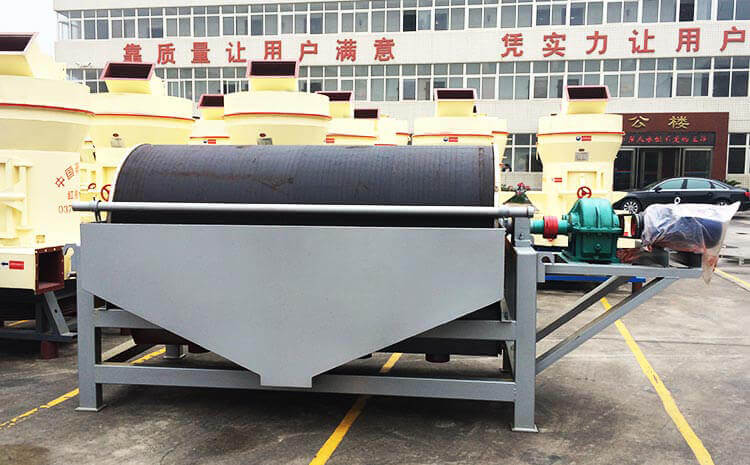The dry magnetic separator is a magnetic beneficiation machine for sorting dry magnetic minerals. It is especially suitable for the separating magnetite, pyrrhotite, roasting ore, ilmenite and other materials with a particle size of 3mm or less, also applied for removal of iron from coal, non-metallic minerals, building materials and other materials.
How to Improve the Dry Magnetic Separator Efficiency?
Main points to improve the dry magnetic separator efficiency: the thickness of the feed layer, the vibration speed of the vibration groove, the magnetic field strength and the working gap.
1. Ore feed layer thickness
The thickness of the feed layer is related to the ore material particle size and the magnetic mineral content. In general, the ore layer of the coarse material is thicker than the fine grain.
When processing the coarse grade, the feed thickness should not exceed about 1.5 times the maximum particle size, while the thickness of the feed layer can reach about 4 times the maximum particle size when processing the middle size grade, and even 10 times for processing fine particle size.
When the content of magnetic minerals in the raw materials is small, the feed layer should be thinner. If it is too thick, the magnetic particles in the lowermost layer will not only receive the less magnetic force, but also be subjected to the pressure of the above non-magnetic ore particles in addition to its own weight, reducing the recovery rate of the magnetic product. When the magnetic mineral content is high, the feed layer may be suitably thicker.
2. Vibration speed of the vibration groove
The vibration velocity of the vibrating trough determines the time the ore stays in the magnetic field and the amount of mechanical force it receives. The larger the product of the vibration frequency and the amplitude of the vibration groove, the larger the vibration speed, and the shorter the residence time of the ore particles in the magnetic field.
The mechanical force acting on the ore particles is dominated by gravity and inertial forces. Gravity is a constant, and the inertial force is proportional to the increase or decrease of the square of the velocity. Weak magnetic minerals are subjected to magnetic forces in magnetic fields that are less than gravity. Therefore, if the speed of the vibrating trough exceeds a certain limit, the magnetic force is not enough to suck them up because of the sudden increase in inertial force, so the weak magnetic minerals The speed of movement in the magnetic field of the magnetic separator should be lower than the speed of movement of the ferromagnetic mineral.
In general, when concentrating process, there are many monomeric minerals in the raw materials, and their magnetic properties are strong, and the vibration velocity of the vibrating trough can be higher. When the scavenging process, the raw material contains more connected organisms, and the magnetic properties of the continuous body are weaker. In order to improve the recovery rate, the speed of the vibration tank should be lower.
For the processing of fine-grained raw materials, the frequency of the vibrating trough should be slightly higher (favorable for loose ore) and the amplitude should be smaller; while the processing of coarse-grained raw materials should be slightly lower and the amplitude should be larger. Appropriate operating conditions should be determined by practice based on the nature of the material and the selection criteria.
3. Magnetic field strength and working gap
The magnetic field strength and working gap are closely related to the particle size, magnetic properties and operational requirements of the material being processed. When the working gap is constant, the strength of the magnetic field between the two magnetic poles is determined by the number of turns of the coil, and the number of turns is not adjustable, so the magnitude of the current is used to adjust the strength of the magnetic field.
The strength of the magnetic field depends on the magnetic properties of the material being processed and the operational requirements. For the strong magnetic minerals and concentrating process, it is better to adpot a weaker magnetic field strength. For weak magnetic minerals and scavenging operations, it should adopt strong magnetic field strength.
When the current is constant, changing the working gap can make the magnetic field strength and the magnetic field gradient change at the same time. Reducing the working clearance causes a sharp increase in the magnetic field force.
The size of the working gap is determined by the particle size and processing requirements of the raw material, which is larger when processing the coarse grade and smaller when the fine grade is processed.
When scavenging, adjust the working gap to the minimum as much as possible to improve the recovery rate; when concentrating, it is best to increase the working gap, reduce the non-uniformity of the magnetic field distribution between the two poles and increase the magnetic ore to the disk teeth. The sharp distance increases the selectivity of the separation and improves the grade of the magnetic product, but at the same time, the current is appropriately increased to compensate for the magnetic field strength reduced by increasing the working gap.
JXSC supplies different magnetic separator machines for various conditions, wet type, dry type magnetic separator for sale.
LATEST PRODUCTS
Twin Screw Feeder
【Feeding Capacity】 10-160 t/h【Power】 2.2-…
Tubular Screw Conveyor
【Capacity】6-50 m3/h【Procesible Material】 …
Heavy Plate Feeder
Capacity: 100-240 m3/h Power: 15-45 kW Speed: 0…










